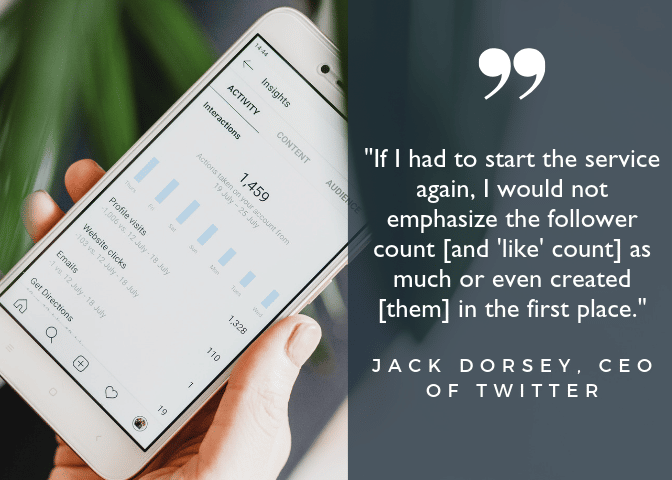


Between keeping up with the latest social media algorithm changes and figuring out how to tie a #ThrowbackThursday hashtag to a whitepaper landing page (oh, it's possible!), marketers overseeing B2B social media always have something to worry about. Since the introduction of the first social media platform (remember Friendster?), follower count has been one of those worries. However, I’m here to let you know: YOUR FOLLOWER COUNT DOESN'T MATTER.
Now, before you send your entire social media following after me, I understand that at one-point follower/fan count was an important metric for several social media platforms. It actually played a role in their algorithms. However, even the founders of these platforms have come forward to acknowledge their dissatisfaction with this “important” metric. The founder of Twitter, Jack Dorsey, stated in a recent TED Talk that, "If I had to start the service again, I would not emphasize the follower count [and 'like' count] as much or even created [them] in the first place." Why? It's a vanity metric.
What are B2B social media vanity metrics?
They are exactly what the name suggests – metrics that look good on paper and help your company feel good, but that don't actually correlate to business goals.
Let's face it. Proving the ROI for social media has been an issue for many B2B marketers. In fact, 40% of marketers still find it hard to prove the value of their marketing activities. However, 76% of B2B tech companies are using social media to drive results, proving that it can be done. How? By focusing on the B2B social media metrics that matter and forgetting about the ones that don't.
So, let’s break down what you should be evaluating.
Reach > Impressions
The first vanity metric to replace in your social media marketing reports is impressions. Impressions refer to the number of times your content or ads appear on a screen, regardless of whether it is seen by your target audience. At one point, impressions were a great metric to use to showcase brand awareness; however, this metric does not actually affect your bottom line. It doesn’t matter if your social content has appeared on a screen if no one actually looks at it.
Instead, look at reach. Reach refers to the number of people who have seen your content or ad after it is posted. Reach is a more accurate measurement for brand awareness because it showcases the number of people actually viewing your content. Seeing a reasonably high reach with a specific piece of content? Then it's safe to conclude that a particular piece of content should be investigated to see why so many people are viewing it. Content that is shared with others contributes to the total reach, which means your followers could be sharing a great piece of content to reach non-followers.
Engagement Rate > Followers
The importance of measuring your social reach leads right into the importance of engagement rate over follower count. If there was ever a battle between metrics that matter and those that don't, this would be it. One of these metrics measures how your content resonates with your target audience, while the other simply measures how many people (and possibly bots) “follow” your social profile. Which would you choose?
As the New York Times notably mentions, "follower counts do not necessarily translate to people actually engaging with posts." Having 100k followers may feel great from a vanity standpoint, but what if only 10 of those followers interact with your content?
This is where engagement rate comes in. It paints a better picture of exactly how your content is resonating with your target audience and whether your current followers are indeed your target audience. Referencing the example above, if your social content reaches all 100K of your followers and only 10 people engage by liking, sharing, commenting or saving, then your engagement rate would only be .0001%, showing that your content is not deemed as relevant and engaging.
According to Rivaliq the median engagement rate across industries is .048%, and Alloy’s clients often see engagement rates exceeding 1%. Using engagement rate wisely prompts better social media strategy decisions on messaging, tone of voice, and persona research.
Conversions > Clicks
Once you have followers engaged, what is the next logical step in the buyer's journey? Converting them into marketing qualified leads (MQLs), of course. Your C-Suite will no doubt challenge investing in social media if it’s not generating prospects, right? This is why conversion metrics matter more than just website clicks.
Many marketers will showcase the number of clicks a website receives from social media as an ROI metric, but the number of page views you receive is only slightly more valuable than the number of followers you have. Page views don't showcase whether the visitors coming from social are the right fit, or whether your products/services are in alignment with their needs. Conversions can. Tracking conversions from leads that come from social platforms not only showcases the value of your social efforts, but also the value of your content. Knowing the metrics, you should follow – and the ones you shouldn’t – is important not only for your social media marketing efforts but for your business. Focusing on vanity metrics relegates B2B social media marketing as a desperate tactic that is not connected to the bigger communications picture of your business. At Alloy, we focus on the whole picture, not just one piece of the puzzle. To see just how we can help you integrate social media into your entire marketing communications lifecycle check out our latest case studies and reach out when you’re ready to PRopel what’s possible.